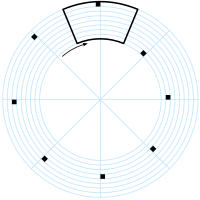History of Television § Broadcasting
Mechanical
Facsimile transmission systems for still photographs pioneered
methods of mechanical scanning of images in the early 19th
century. Alexander Bain introduced the facsimile machine between 1843 and
1846. Frederick Bakewell demonstrated a working laboratory version in 1851. Willough
by Smith discovered the photoconductivity of the
element selenium in 1873. As a 23-year-old German university student,
Paul Jukius Gottlieb Nipkow proposed and patented the Nipkow disk in
1884. This was a spinning disk with a spiral pattern of holes in it, so
each hole scanned a line of the image. Although he never built a working model
of the system, variations of Nipkow's spinning-disk "image rasterizer "
became exceedingly common. Constantin Perskyi had coined the word television in
a paper read to the International Electricity Congress at the International
World Fair in Paris on 24 August 1900. Perskyi's paper reviewed the
existing electromechanical technologies, mentioning the work of Nipkow and
others. However, it was not until 1907 that developments in amplification tube
technology by Lee de Forest and Arthur Korn, among others, made
the design practical.
The first demonstration of the live
transmission of images was by Georges Rignoux and A. Fournier in Paris in 1909.
A matrix of 64 selenium cells, individually wired to a mechanical
commutator, served as an electronic retina. In the
receiver, a type of Kerr cell modulated the light and a series of variously
angled mirrors attached to the edge of a rotating disc scanned the modulated
beam onto the display screen. A separate circuit regulated synchronization. The
8x8 pixel resolution in this proof-of-concept demonstration was just
sufficient to clearly transmit individual letters of the alphabet. An updated
image was transmitted "several times" each second. In 1921 Edouard
Belin sent the first image via radio waves with his belinograph.
In 1911 Boris Rosing and
his student Vladimir Zworykin created a system that used a mechanical
mirror-drum scanner to transmit, in Zworykin's words, "very crude
images" over wires to the "Braun tube" (cathode ray tube or
"CRT") in the receiver. Moving images were not possible because, in
the scanner: "the sensitivity was not enough and the selenium cell was
very laggy". To be Continue

The Nipkow disk. This schematic shows the circular paths traced by the holes that may also be square for greater precision. The area of the disk outlined in black shows the region scanned.

Baird in 1925 with his televisor equipment and dummies "James" and "Stooky Bill" (right).



Comments
Post a Comment